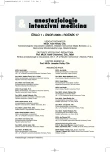Vascular anaesthesia at the beginning of the third millenium
Authors:
P. Michálek 1,2; M. Stern 3; V. Kubricht 3; J. Šoupal 4
Authors‘ workplace:
Dept. of Anaesthetics, Antrim Area Hospital, Antrim, United Kingdom
1; IPVZ, Praha, Česká republika
2; Úsek kardiovaskulární anestezie a intenzivní péče, Nemocnice Na Homolce, Praha, Česká republika
3; Dept. of Cardiothoracic Anesthesia, Washington University Hospital, St. Louis, Missouri, USA
4
Published in:
Anest. intenziv. Med., 17, 2006, č. 1, s. 21-29
Category:
Anaesthesiology - Comprehensive Report
Overview
Anaesthesia for vascular surgery has been developing rapidly in the last decade, simultaneously with surgery. The anaesthetist must master a broad spectre of manual skills and theoretical knowledge. Pulmonary artery catheters and/or transoesophageal echocardiography are frequently used in aortic surgery to monitor the haemodynamics. Another option is to estimate cardiac output by analysis of the arterial pressure curve. Monitoring of the neurological function of the brain and spinal cord is necessary in carotid surgery and descending aortic procedures. Haemocoagulation disorders are monitored using thrombelastography and Sonoclot. In this article the authors discuss the choice of anaesthesia for carotid surgery. A clear benefit of either regional or general anaesthesia has not been manifested. The use of dexmedetomidine for conscious sedation during these procedures under regional anaesthesia is discussed, as well as the options for decreasing cardiac morbidity and mortality. Anaesthesia for procedures on the abdominal,descending and thoraco-abdominal aorta is reviewed with a special consideration for the pathophysiological changes associated with aortic cross-clamping. Organ preservation below the clamp level is a very important part of perioperative care. The authors discuss the current options of non-dependent lung ventilation in descending aortic surgery including high-frequency jet ventilation, as well as the up-to-date approach to the preservation of the spinal cord function. Catastrophic events in vascular surgery include a ruptured aortic aneurysm, a ruptured aortic aneurysm with previously inserted stentgraft, repair of aorto-caval fistula, acute obtruction of the abdominal aorta and emergency vascular procedures in the patient with cardiac failure. These procedures carry a high mortality rate despite adequate perioperative care. Novel trends are being developed in vascular surgery to decrease the invasiveness of the procedure. Other objectives in the development of new methods include decreasing the perioperative morbidity and mortality rates and reducing the length of hospital stay. These procedures include endovascular and endoscopic vascular procedures, radiofrequency sympathectomies and combined cardiac-vascular procedures.
Key words:
haemodynamic monitoring – neuromonitoring – thrombelastography – carotid surgery – aortic procedures – infrainguinal vascular procedures – emergency procedures – endovascular surgery – endoscopic vascular surgery
Labels
Anaesthesiology, Resuscitation and Inten Intensive Care MedicineArticle was published in
Anaesthesiology and Intensive Care Medicine

2006 Issue 1
Most read in this issue
- Vascular anaesthesia at the beginning of the third millenium
- The cardiovascular system in the elderly and perioperative risk
- Antifibrinolytic agents in off-pump cardiac surgery: analysis of blood loss, safety and cost-effectiveness
- The prospective study on the effect of a preemptive long-term postoperative administration of a low-dose ketamine on the incidence of chronic post-mastectomy pain
